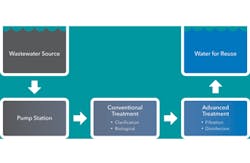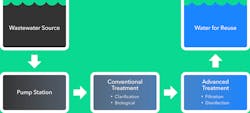Water resources were taken for granted for decades, but now are seen critical for companies, communities and governments, as issues of environmental sustainability, both globally and in local context, come to the fore.
Only 2.5 percent of the world’s water is fresh, and much of that is trapped in glaciers and snowfields. One estimate says only about 1 percent of this freshwater is "accessible," i.e., available for everyday use. In another estimate, if current trends continue, global fresh water demand will exceed supply by a staggering 40 percent in 2030.
By reducing source-water requirements, any food & beverage company lessens its environmental impact. Many companies also realize substantial cost savings from water-related investments.
Other benefits of water reuse include 1) enhanced sustainability practices; 2) more appropriate water-quality standards for food & beverage processes; and 3) mitigated business risk through lessened dependency on external water sources.
Water reuse is growing around the world. Read further to understand more about its deployment, including issues bearing on investment decisions.
Terms & definitions
Wastewater is typically discharged into a collection network, to be treated by publicly owned treatment works (POTW) or under the national pollutant discharge elimination system (NPDES).
In the U.S., publicly owned facilities are the business of local governments or municipalities, and treat domestic sewage, not industrial wastewater. Some industrial facilities are permitted to discharge water to public treatment works if they follow pretreatment processes such as for solids removal, biochemical oxygen demand (BOD) reduction and pH adjustment.
Public treatment works are sensitive to industrial discharge due to potential impact on facility operations. Many require corporations to pull permits for discharge and charge significant fees. In addition, fines and other penalties can be imposed for discharge permit violations.
The discharge of water into a river, lake, creek or other body of water falls under the purview of the national pollutant discharge elimination system, a division of the EPA, already mentioned. Companies looking to discharge wastewater through the national discharge system need water more heavily treated than if discharged to public treatment works.
As a government-regulated system, strict permit requirements govern this type discharge.
In fact, these standards often are more stringent than those imposed for reuse. Violations of discharge requirements can result in EPA-issued punitive fines and consent decrees, which subject plants to routine inspections to ensure standards compliance. Should mandated provisions not be followed, a company could also find itself paying for environmental damage remediation.
Whether discharging wastewater through POTW or NPDES, a company should consider its full cost of wastewater disposal when evaluating treatment and reuse.
The technology of reuse
Conventional solid waste removal can include use of screens, dissolved-air flotation and primary clarifiers, filters, biological treatment via conventionally-activated sludge, chlorination and pH adjustment, reducing solids and Biochemical Oxygen Demand (BOD). It provides minimal disinfection and, for some reuse applications, such as turf irrigation, conventional treatment may be all that is needed.
Advanced technologies can remove contaminants that conventional treatments can’t and are applied based on specific needs, including the following:
- microfiltration or ultrafiltration membranes for solids and bacteria removal
- sequencing-batch or membrane-bio reactors for biological nutrient removal
- reverse osmosis for removal of dissolved organics or salts
- oxidation and disinfection to remove trace contaminants and pathogens
- adsorption or ozone-enhanced biological active filtration to remove dissolved organics and contaminants
These advanced treatments can be roughly categorized as either biological or disinfection.
Biological treatment further includes two subcategories: sequencing batch reactor (SBR) and membrane bioreactor (MBR). In general, sequence-batching needs less capital investment, but a membrane bioreactor can cost less to operate.
Both combine biological treatment with membrane filtration to 1) provide a high quality effluent and 2) meet stringent nutrient limits for phosphorus and nitrogen. For a more detailed comparison of SBR to MBR, refer to Table 2.
Kinds of disinfection
The most basic is chlorine disinfection. Here, water is filtered with hypochlorite to generate chlorine residual to inactivate pathogens such as bacteria.
UV technologies are chemical-free and need less contact time than chlorine disinfection. In these systems, water is channeled through a reactor that emits UV light at low wavelengths to destroy the DNA structures of microorganisms, including bacteria, viruses, yeasts and molds. Virtually any liquid can be used with this technology, so it is often found in beverage-processing plants.
However, UV is sensitive to water clarity. Higher clarity water requires less energy to treat, and as a result, pretreatment of wastewater is common in systems where UV disinfection is used.
Ozone and advanced oxidation processes (AOP) are powerful oxidation treatment technologies that generate hydroxyl radicals, the strongest oxidant used in water treatment. AOP is an ideal disinfection approach to treat recalcitrant contaminants not removed by other technologies. AOP and ozone technologies are commonly coupled with other filtration technologies.
Table 3 outlines a cost-benefit analysis of common disinfection technologies.
Membranes & osmosis
In addition to biological and disinfection techniques, other advanced treatments are used either separately or in conjunction to fulfill wastewater discharge requirements.
Membrane filtration, including microfiltration and ultrafiltration, is for suspended-solids removal in food & beverage processing. The technologies remove some pathogens, viruses and bacteria. See Table 4 for a breakdown of filtration types.
In reverse osmosis, salts and many dissolved organics are removed through a semi-permeable membrane. Reverse osmosis is used for highest-quality reuse water, such as high-pressure boiler feedwater or for low salt and contaminant levels. Reverse osmosis is expensive and generates a concentrate brine waste-stream that must be managed via proper disposal.
Treating water is only the first step to ensuring wastewater is recycled and reused efficiently and effectively within a plant. It is important for organizations to also consider the transportation and storage of water reuse.
Pumps & pressures
Pumps both transporting and boost pressure in a system. Water is moved from one spot to another for treatment, storage purposes or use. Pressure boosting is needed for treatments, including reverse osmosis, where water moves through a membrane at specific pressures. Many reuse applications, such as irrigation and equipment washing, also require pressure-boosting.
Pumps and piping impact considerably the energy consumed over a system’s lifecycle. Pumps should be selected to operate at their best efficiency point (BEP) and plumbing engineered to minimize friction loss. Xylem estimates that a water reuse system with improperly sized piping and pumps can increase energy consumption by 200 to 300 percent.
With increasing droughts and other water-related anomalies, water reuse must be front and center for food & beverage plants bent on sustainability and a secure water supply. It speaks also to a greater focus on social responsibility and water stewardship. In part, due to public indices such as the Dow Jones Sustainability Index, companies are investing more heavily in sustainability than ever before and are better managing their water use.
Another driver of water reuse is health and safety mandates. Food & beverage operations must comply with the Food and Drug Administration, as well as the EPA and other relevant regulatory bodies. Standards put in place by these organizations to regulate wastewater quality vary, but apply in some form to all plants, regardless of size. For example, in 2012, the EPA released a document outlining state and federal water reuse guidelines for all industries, including food and beverage processing.
The reuse takeaway
- Multiple treatment options are available for specific needs – a variety of conventional and advanced treatment processes can be configured for any facility and tailored to be fit-for-purpose depending on the application.
- Choose equipment that results in long-term benefits – A plant’s total water and wastewater costs are significant and will continue to rise. Employing the correct reuse technologies can result in both hard and soft savings for your organization, including reduction in supply risk and benefits to the environment.
- Collect the necessary information to start the process – Now that you’ve decided to start reusing water, the first step is to define some objectives. Consider both financial and environmental goals.




